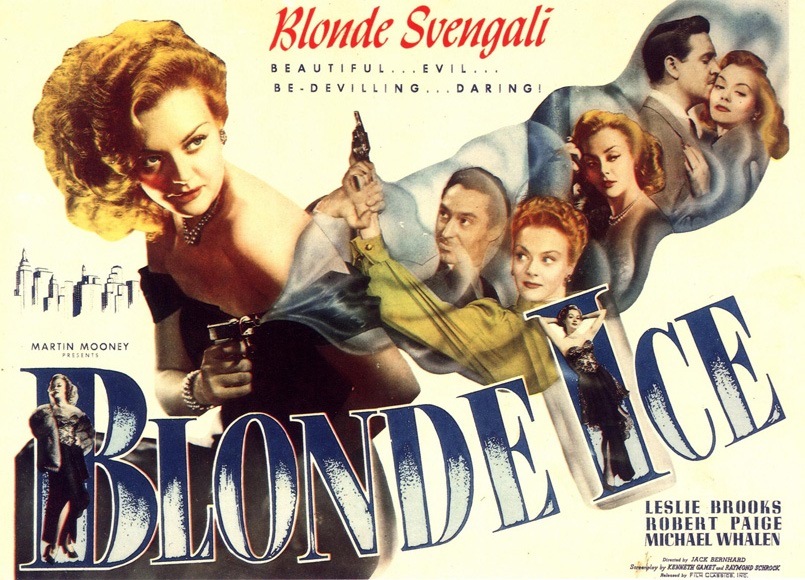Blonde Ice announces right off the bat what kind of movie it’s going to be when we drop in on the wedding of society reporter Claire Cummings (Leslie Brooks) to well-heeled Carl Hanneman (John Holland). A handful of her male co-workers at the newspaper are wondering how a woman who was in the steno pool only a few years before is now marrying a millionaire; one of them, smarmy crime reporter Al Herrick (James Griffith), thinks he’s got it figured out, showing the other gents a cigarette case she once gave him, inscribed “With all my love, Claire”. Of course, it turns out they’ve all got one of those cases, and within minutes of saying “I do”, Brooks is already putting the moves on Les Burns (Robert Paige), a sportswriter and another of her former beaus.
Brooks’ infidelity is so brazen that it’s almost ridiculous; she’s so careless about writing mash notes to Paige (on the first day of her honeymoon!) that you wonder why she bothered to get married in the first place, or how big a chump Holland must have been to marry her. (One clue to her sharklike movement through her social circles comes when she catches Griffith fondling his cigarette case; she gives him a look that make him react like a 10-year-old who’s been caught pissing in the baptismal font.) Holland discovers her infidelity in about five seconds, and not 24 hours after that, he’s slumped over dead in his favorite chair and she’s getting a ride home from the airport from the loyal but stupid Paige. When a judge makes it clear that he’s not buying her claim that Holland committed suicide, Paige is left to dangle and Brooks is fixed on a new conquest — Holland’s attorney, Stanley Mason (Michael Whalen)– to protect her neck.
Yes, Brooks is the most fatal of femmes fatale; her scheming is so reckless it begins to take on a sort of unmotivated extravagance. The question of whether or not the role of the femme fatale allowed female characters of the otherwise repressive ’40s and’50s an agency they’d otherwise lack isn’t even a question in Blonde Ice; she’s evil through and through, with practically no subtlety or cause, a pure destructive bitch who causes trouble just because she can. A better actress might have salvaged this thankless role (director Jack Bernhard was also known as Mr. Jean Gillie, who he directed in the far superior Decoy, and given how toothily she played the femme fatale in that movie, it’s very tempting to say what she might have done here), but she’s not really up to the task.
For that matter, neither is anyone else. Irving Gertz’s score bears a strong sentimentality at times to Howard Shore’s work in The Silence of the Lambs, but otherwise this is a very star-studless affair; Paige is a lumbering chump, a would-be romantic subplot with his secretary (Mildred Coles) collapses under its own weightlessness, and the rest of the cast is equally uninspiring, with the sole exception of the slick Griffith, who everyone seems to hate even though he’s the only one fully hip to Brooks’ flagrantly awful machinations. Bernhard’s direction is anonymous, and there’s virtually no noir fireworks in the script, editing, or cinematography, all of which are pulled off by largely anonymous studio cogs. Indeed, Blonde Ice‘s most notable noir characteristic it how clear it is that it’s a C-list Poverty Row picture. The few San Francisco exteriors are obviously stock, crowd scenes are filmed in such a way as to keep the number of extras to a minimum, and its back-lot nature is as apparent as Brooks’ conniving.
In fact, the person who earned their keep the most on this dud was the unnamed writer who wrote its over-the-top marketing copy: “Ice in her veins — icicles in her heart! A frigid female whose fury ripped through men’s souls! Blonde Svengali — evil — bedeviling — daring!” That’s more exciting, and kinkier, than anything in the movie; even Brooks’ loony villainy doesn’t add up to a big enough body count to lend the flick any tension, and the late-innings addition of a tricksy psychiatrist only plays up what a sucker Paige is. It’s also not a great visual treat; the film restorer gets 20 seconds worth of screen credit at the beginning of the DVD, but it’s hard to see what he accomplished, as there’s very little in the way of extras (not even subtitles), the sound is muddy, and the transfer is murky and lacks all sharpness. If you want to see three more or less identical mustachioed and Brilliantined goofs falling all over themselves for the most obvious gold-digger since James Wilson Marshall, you might get a kick out of Blonde Ice, but if not, well, it’s barely over an hour long, so you won’t lose much more time than you would to an episode of The Rockford Files.

